“Some films have certain scenes that need to be redone, but on This Means War the whole picture should have been sent back for a reshoot. This perfectly dreadful romantic action comedy manages to embarrass its three eminently attractive leading players in every scene, making this an automatic candidate for whatever raspberries or golden turkeys or other dubious awards may be given in future for the films of 2012. It’s an eye-roller from start to finish.” — from Todd McCarthy‘s 2.9 Hollywood Reporter review, posted at 7:09 pm.
Day: February 9, 2012
Death Becomes Them
Why would I want to see a Deep Impact relationship comedy? What’s funny about cops who still give tickets and particularly people who give a damn about cops giving tickets with a meteor about to smash into earth in three weeks’ time? What’s funny about a maid who gets offended when told she doesn’t have to return to clean? How can anyone be expected to invest anything whatsover in a relationship happening under the cloud of certain doom?
Focus Features is opening Seeking A Friend for the End of the World, which costars Steve Carell and Keira Knightley and was written by Lorene Scafaria, on 6.22.
Calico
Brian M. Cassidy and Melanie Shatzky‘s Francine, a drama starring Melissa Leo as an ex-con sturggling to find fulfillment, will premiere at the Berlin Film Festival on Monday, 2.13. An Indiewire synopsis says that Leo’s character’s “failure with human connection leads her to seek support from animals, with tragic consequences.”
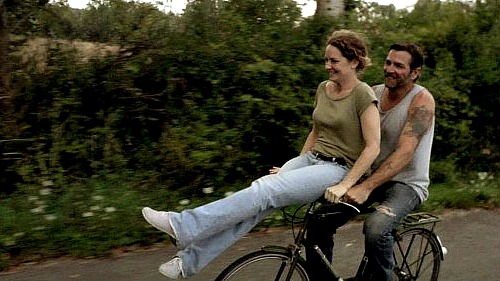
As a writing class experiment, HE readers are requested to take five minutes and explain how a middle-aged woman seeking support from “animals” — obviously a reference to a Calico cat — could lead to “tragic consequences.” Let’s see…the cat is a stray who comes by for food scraps at dinner, and Leo adopts him as her pet. One day she notices some kids tormenting the cat (swinging it around by its tail or something) so she takes revenge on the kids and their parents find out and a violent confrontation results.
Why is Leo pictured as being nude as she’s holding the cat? What that could mean?
The synopsis also says that “her path through life is much like an orbiting satellite: detached, lonely and ultimately destined to crash.”
Back For More
Every couple of years I post a short clip from What’s Up Tiger Lily?. It’s a longstanding Hollywood Elsewhere tradition. There’s no clip of my favorite scene (the royal bearded guy pulls out a small map and says, “This is Shepherd Wong’s home,” and Phil Moskowitz asks, “He lives in that piece of paper?”) so I had to go with this.
Rebecca Redux
Variety‘s Jeff Sneider is reporting that DreamWorks and Working Title Films have agreed to pool forces on a remake of Alfred Hitchcock‘s Rebecca. The script will be written by Eastern Promises scribe Steven Knight, who “will go back to the original book” by Daphne DuMaurier. Has there ever been a trade story about a remake of a well-known Hollywood classic in which the principals didn’t say they’d base their script on the original book?
I’ll tell you what it’ll mean to “go back” to the DuMaurier book. Maxim De Winter (played by Laurence Olivier in the Hitchcock original) won’t confess to having “struck” Rebecca, causing her to accidentally hit her head and die — he’ll admit that he flat-out shot her. That’s all it will specifically mean as the Hitchcock version stuck close to the novel save for letting Maxim off the hook.
What also will happen, of course, is that the new film will leave less to the imagination and be more explicit in various ways so as to meet the expectations of today’s less educated and sophisticated girly-girl audience. The lesbian current between Rebecca and Mrs. Danvers (whether verbally suggested or dramatized in flashback) will almost certainly be more explicit. The nameless lead character (played by Joan Fontaine in the 1940 original) will probably be given a name. The dead Rebecca will become a literal ectoplasmic ghost, I’m guessing, and will also be played by an actress in flashbacks. Will the DreamWorks-Working Title version keep the story in period, setting it in the late 1930s, or will they bring it into the 21st Century so as make it more familiar and inviting to the none-too-brights?
Surprise Approval
There’s nothing in Daniel Espinosa‘s Safe House (Universal, 2.10) that you haven’t seen many times before. Set in South Africa, it’s a cookie-cutter Bournedoggle about a CIA rogue-on-the-run (Denzel Washington) and a safe-house operative (Ryan Reynolds) who’s trying to keep him in cuffs. It’s shot like the Bourne series (hand-held, grainy photography, jazzy cutting), and Washington-Reynolds do a decent job with all the hand-to-hand combat and gunplay and car madness.
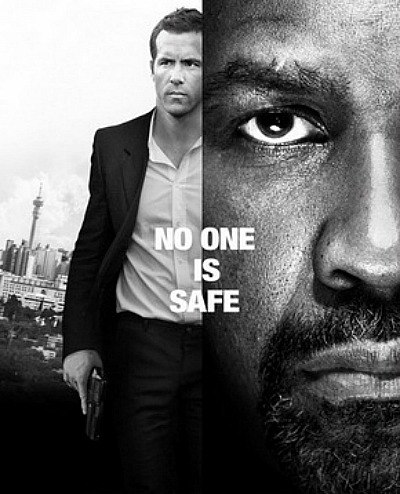
But…BUT!…I never felt bored or burned because the Swedish-born Espinosa, 34, really knows how to shoot and stage action like Tony Scott or Paul Greengrass. Or at least he knows how to work well with cinematographer Oliver Wood, who shot all three Bourne films. Espinosa seems to get the rules of this realm and understand a thing or two about thrillers (his 2010 film Easy Money was a huge Swedish hit), and he earns points for keeping the Bourne shakey-cam aesthetic on a leash.
And there’s certainly a comfort factor in watching a film that’s been made by someone who’s obviously more skilled than your average DGA clock-puncher. The very beginning, for instance, focuses on domestic small-talk dialogue between Reynolds and his French live-in girlfriend (Nora Arnezeder). It’s just a typical set-up scene, but Espinosa shoots in such a way that keeps you attuned and intrigued. He doesn’t frame or cut anything in rote fashion.
So even though it’s the usual razmatazz, you could do worse than see Safe House this weekend. I’ve seen the same chops and plot points used 18 or 89 times before (I’ve lost count) and the script delivers almost nothing original but I’m a sucker for well-engineered shooting and cutting. Go ahead, call me shallow. Guilty.
Man Facing East
Due respect for the ad-poster guys but out of politeness one should never run a photo of an older man in profile as this always accentuates the neck waddle and the paunch.
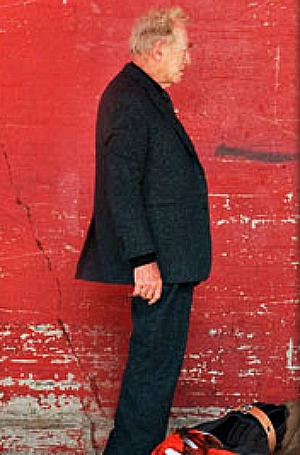
No comment implied about Von Sydow’s performance in Extremely Loud & Incredibly Close, of course, which is fine for what it is. He’s been working like a champ since the mid ’50s, and is obviously one of our greatest older actors. My favorite MVS perfs are contained in The Virgin Spring, Shame, Three Days of the Condor and Hannah and Her Sisters,
The Artist’s Older Brothers
I’ll bet all the ad money I’ve earned during Phase One and Phase Two that 95% of the Academy members who love The Artist (or at least are giving it their Best Picture vote) have never heard of OSS 117: Cairo, Nest of Spies (’06) or OSS 117: Lost in Rio (’09), much less seen them.


They should at least be aware of them and what they are. Because these two clever comedies — 007 spoofs released in ’06 and ’09, directed by Michael Hazanavicius, starring Jean Dujardin and costarring (in the Cairo film) Berenice Bejo — are cut from the same cloth as The Artist. In fact they’re the same basic shtick.
All three are driven by a reflective tribute-to-the-past mentality, and are extremely scrupulous in replicating the particulars. The difference with The Artist, of course, is that it invests in pathos and tragedy in act three instead of deadpan comedy start to finish. But the depth factor is pretty much the same. All three are about cinema style and recombining elements and turning old-time genres and forms into refreshments.
If Academy chiefs were to insist that AMPAS members attend special screenings of OSS 117: Cairo, Nest of Spies and OSS 117: Lost in Rio this week, many planning to vote for The Artist would change their minds for two reasons. One, they’d realize that Hazanavicus, Dujardin and Bejo have been working this routine for five or six years and that The Artist isn’t quite as inspired as they’d thought. And two, many would realize that the spy spoofs are just as exacting and dead-on in recreating early 007 films as The Artist is in reviving the silent black-and-white era of the 1920s, and that the OSS films are funnier and more pleasing.
That’s how I feel, at least. The OSS films are a kick. And purchasable through Amazon.
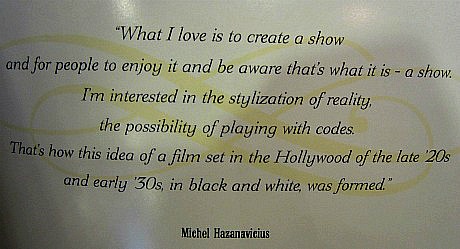
Statement by Michel Hazanavicius in the 2011 Cannes Film Festival program notes.
Bubbly Swoony
On 1.29 a National Public Ratio “Weekend Edition” interview between Rachel Martin and Awards Daily Sasha Stone aired. (And was posted.) It’s a short piece about the Best Adapted Screenplay Oscar, and about as simple-minded as an interview of this sort could possibly be without attempting to satirize.
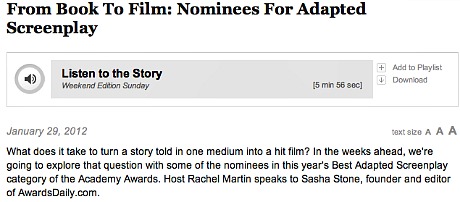
We all think of NPR as a haven for bright and informed conversation, but this piece was assembled for the slowest ADD person in the room. I guess the NPR motto has always been “keep it simple and peppy and above all not too long.” (Kim Masters‘ pieces are like this too.) After all, they don’t want to lose any eighth graders who might be station-surfing and stopping on NPR for a few seconds. Really, listen to this thing. Audio clips, audio clips and more audio clips. Keep the commentary down to the bare minimum. Assume your listeners are borderline idiots and you can’t go wrong.
Stone elaborated today on what she was trying to convey to Martin…if Martin had any interest in discussing the subject at any length.
Key point #1: “It surprised host Rachel Martin that the screenplay race, it turned out, wasn’t so much about the individual screenplays as it was about the Best Picture category. Key point #2: “She was also surprised to hear that those voting for adapted screenplay don’t have to have seen all of the films nominated. Heck, the year Brokeback Mountain lost to Crash many Academy members came out and admitted they didn’t see the movie. This year, if you polled Academy members I bet you’d find that there are those voting members who still haven’t seen all nine of the nominees.
“Voting is buzz and perception. When you fall in love with a pretty girl across the room not only do you not see anyone else but you don’t even want to look at anyone else. Such is the conundrum of choosing ‘best.'”
This is why I spit on the 2011 Awards Season consensus picks among many of the critics groups, the guilds, the HPA and the Oscars. In terms of Best Picture, Best Director and Best Actor, I mean. I don’t mind that people have crushes on this performance or that film. I find nothing wrong with a little swooning from time to time. I do mind when the most popular kid in the room is by far the shallowest and most smiley and superficially charming without any corresponding depth or intrigue or complexity.
I used to hate guys like this in high school. Hunky jocks and grinning student council officers in their fucking slacks and loafers and Brooks Brothers shirts. They had next to nothing going on upstairs — certainly none of the depth or wit or soul that I was secretly harboring — and yet all the pretty girls loved them because they were cute and charming and “sincere” and…I don’t know, comforting or whatever. I’ve had the last laugh, of course. Right now many of those guys are enduring lives of comfortable middle-class tedium and boredom while I’m galavanting around Hollywood and Cannes and rubbing shoulders with hot girls and schmoozing with all the cool people. But I still hate them for all the “like” they received in our junior and senior years.
Damn Straight
“Brad Pitt‘s performance [in Moneyball] is an almost old-fashioned, movie-star one,” the narrator says in this 2.9 Press Play “Should Win” essay. Nope, not “almost” — it is a movie-star performance, and an intimate and revealing one at that. On the level of George Clooney‘s vulnerable anguish in The Descendants, and way, way beyond what Jean Dujardin delivers in The Artist.
“In another universe, one could imagine Jimmy Stewart or Cary Grant taking the part,” the narrator continues.
Yeah, Stewart of the early ’50s could have strode around in Billy Beane’s shoes. Or William Holden or James Garner. But not Grant. When it comes to baseball, Cary Grant is strictly a spectator. (I’m recalling how he seemed slightly out of place when he took in a N.Y. Yankees game with Doris Day in That Touch of Mink.) In Moneyball you believe right away that Pitt has baseball in his blood. He sells that when he throws his radio out of his car, and then gets out and walks over and repeatedly stomps on it. Cary Grant does the horse-whinny thing and gets angry, but he doesn’t stomp on things.
“[Pitt] brings to the role an assured quality of overzealous, yet understated, lust for ultimate success that was forged in the fires of years and years of failure,” the narrator goes on. “He’s charming and cheeky and funny, and very good looking (despite the hideous early naughties’ haircut and lumbering fashion sense). Pitt brings a subtle comedic take to what could have been a rather boring central role; his various dealings with other managers, his scouts and players, betray genius-level timing and mimicry.”
You know who also delivers genius-level comic timing? Without having any conventional laugh lines to work with? Phillip Seymour Hoffman as Art Howe. His shining moment happens in Act Two when Pitt knocks on his office door and says “Art, got a minute?” Hoffman registers three or four emotions in the space of three or four seconds — rage, indigestion, depression, resignation — before grunting “Yeah, what’s up?” I laugh at this each and every time I’ve watched this scene, and I’ve watched it a good ten or twelve times.
There is more move-magic wonder and transportation in those three or our seconds than in all the grinning and tap-dancing and dog tricks and exaggerated mugging in the entire 100-minute length of The Artist.
Ali Arikan, chief film critic of Dipnot TV, wrote the piece. Dave Bunting, Jr. did the narration. Ken Cancelosi cut it together.
